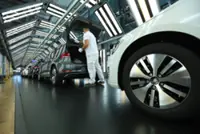The Tesla trend also comes at a time when Uber and Lyft Inc are on the hook to show progress toward achieving their goal of switching entirely to EVs in Europe and North America by 2030. — AFP
Some Uber and Lyft drivers are finding that renting or buying a Tesla, the luxury electric car, is a more profitable option now amid soaring gas prices that have upended the economics of gig work.
Last summer, Heidi Barnes, 34, thought about upgrading her beloved 2009 Toyota Camry, which she nicknamed "The Beast,” for a sleek Tesla Inc Model 3 sedan. The Lancaster, California-based driver never imagined that the high-end vehicle would become less of a splurge and more like a last resort until the average price for a gallon of gas in the US surpassed US$4 (RM17) for the first time in March. Almost overnight, a full tank went from costing Barnes roughly US$60 (RM263) to a day to more than US$100 (RM440), making it harder to make a decent profit from ferrying passengers around Los Angeles County. "It was a huge push to get in a Tesla sooner rather than later,” Barnes said.
Already a subscriber? Log in
Save 30% OFF The Star Digital Access
Cancel anytime. Ad-free. Unlimited access with perks.





